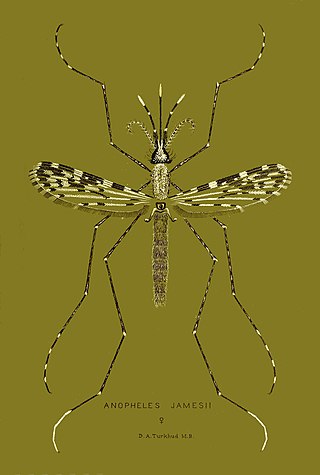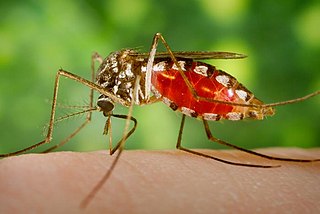
Brugia malayi is a filarial (arthropod-borne) nematode (roundworm), one of the three causative agents of lymphatic filariasis in humans. Lymphatic filariasis, also known as elephantiasis, is a condition characterized by swelling of the lower limbs. The two other filarial causes of lymphatic filariasis are Wuchereria bancrofti and Brugia timori, which both differ from B. malayi morphologically, symptomatically, and in geographical extent.

Aedes pembaensis is a mosquito.
Mansonia mosquitoes are big, black or brown mosquitoes with sparkling on their wings and legs. They breed in ponds and lakes containing certain aquatic plants, especially the floating type like Pistia stratiotes and water hyacinth. The eggs are laid in star-shaped clusters on the undersurface of leaves of these plants. The larvae and pupae are found attached to the rootlets of these plants by their siphon tubes. They obtain their air supply from these rootlets. When about to become adult, these pupae come to the surface of water and the fully formed adults emerge and escape. The control of Mansonia mosquitoes is easy by removal or destruction of the aquatic host plants by herbicides.
Spondweni virus is an arbovirus, or arthropod-borne virus, which is a member of the family Flaviviridae and the genus Flavivirus. It is part of the Spondweni serogroup which consists of the Sponweni virus and the Zika virus (ZIKV). The Spondweni virus was first isolated in Nigeria in 1952, and ever since, SPONV transmission and activity have been reported throughout Africa. Its primary vector of transmission is the sylvatic mosquito Aedes circumluteolus, though it has been isolated from several different types of mosquito. Transmission of the virus into humans can lead to a viral infection known as Spondweni fever, with symptoms ranging from headache and nausea to myalgia and arthralgia. However, SPONV is phylogenetically close to the ZIKV, it is commonly misdiagnosed as ZIKV along with other viral illnesses.

Anopheles (Cellia) jamesii is a species complex of mosquito belonging to the genus Anopheles. It is found in India, and Sri Lanka, Bangladesh, Cambodia, China, Laos, Malaysia, Myanmar, Nepal, Thailand, and Vietnam. It is a potential natural vector of bancroftian filariasis in Sri Lanka.
Anopheles (Anopheles) peditaeniatus is a species complex of mosquito belonging to the genus Anopheles, of the Hyrcanus Group. It is found in India, and Sri Lanka, Iran, and Bangladesh. It is a potential natural vector of bancroftian filariasis in Sri Lanka.
Aedes (Neomelaniconion) lineatopennis is a species complex of zoophilic mosquito belonging to the genus Aedes. It is found in Oriental Regions such as India, Sri Lanka, and also in Eastern & Southern Africa, Nigeria, Japan, Malaysia, and Australia. Female has a wing length of 4 to 5mm. Head scales golden, curved and narrow. Male with tentacles over long beak, distal with wool.
Aedes (Downsiomyia) niveus is a species complex of zoophilic mosquito belonging to the genus Aedes. It is found in Sri Lanka, India, Vietnam and other South East Asian countries. It is a vector of filariasis.
Aedes scatophagoides is a species complex of zoophilic mosquito belonging to the Mucidus Group of the genus Aedes.
Armigeres (Armigeres) aureolineatus is a species complex of zoophilic mosquito belonging to the genus Armigeres. It is found in Sri Lanka, India, Malaya, Cambodia, Laos, Nepal, Philippines, Vietnam, Thailand, Indochina, China, and Borneo. Larvae are collected from discarded containers, coconut shells and dirty water pools. It is known as a vector for avian diseases and few mammalian diseases.

Armigeres (Armigeres) subalbatus is a species complex of zoophilic mosquito belonging to the genus Armigeres. It is found in Sri Lanka, India, Bangladesh, Myanmar, Pakistan, Nepal, Japan, China, Korea, Taiwan, Ryukyu-Retto, Indochina, Thailand, and Guam.
Coquillettidia (Coquillettidia) crassipes is a species complex of zoophilic mosquito belonging to the genus Coquillettidia.
Mansonia (Mansonioides) annulifera is a species of zoophilic mosquito belonging to the genus Mansonia.
Mansonia indiana is a species of zoophilic mosquito belonging to the genus Mansonia. It is found in Sri Lanka, Java, India, Myanmar, Malaya, Singapore, Sumatra, Thailand, and New Guinea. It is a vector of nocturnally subperiodic Brugia malayi. Females are known to be strongly anthropophilic. Larvae found only in association with Pistia species.
Toxorhynchites (Toxorhynchites) splendens is a species of non-hematophagous mosquito belonging to the genus Toxorhynchites. It is widely used as a predator to control dengue mosquitoes.
Culex (Culex) gelidus is a species of mosquito belonging to the genus Culex. It is found in India, Sri Lanka, Bangladesh, Cambodia, China, Hong Kong, India, Indonesia, Japan, Laos, Malaysia, Myanmar, Nepal, New Guinea (Island); Papua New Guinea, Pakistan, Philippines, Taiwan, Thailand, Vietnam. In 1976, it was identified as a major vector of Japanese encephalitis virus, in India. From an experiment, it was evident that aqueous solution of Calotropis gigantea leaves possess larvicidal activity, mosquito repellent activity and ovicidal activity against Culex gelidus.
Culex (Oculeomyia) infula is a species of mosquito belonging to the genus Culex. It is found in Bangladesh, India, Indonesia, Malaysia, Myanmar, Nepal, Philippines, Singapore, Sri Lanka, Thailand, and Vietnam. Adults mainly feeds on cattle but infrequently shows a low proportion of human and bird blood meals. Larvae can be found in water courses with high content of algal populations. In 1998, the species was identified as a vector of Japanese encephalitis virus.
Culex (Culex) pseudovishnui is a species complex of mosquito belonging to the Culex vishnui group of the genus Culex. It is found in Bangladesh, Cambodia, China, Hong Kong, India, Indonesia, Iran, Iraq, Japan, South Korea, Laos, Macau, Malaysia, Nepal, New Guinea (Island); Papua New Guinea, Pakistan, Philippines, Singapore, Sri Lanka, Thailand, Taiwan and Vietnam. It is a major vector of West Nile virus, and Japanese encephalitis virus Larvae can be found from the edges of rice fields. Adults can bite vertebrates from both indoor and outdoor places with a peak biting time on 7pm onwards.
Culex (Lophoceraomyia) uniformis is a species of mosquito belonging to the genus Culex. It is found in India, Malaysia, Hainan Island, New Guinea, Philippines and Sri Lanka. A sup-species Culex (Lophoceraomyia) uniformis ssp. mercedesae is named after the Filipino acarologist Mercedes Delfinado.



